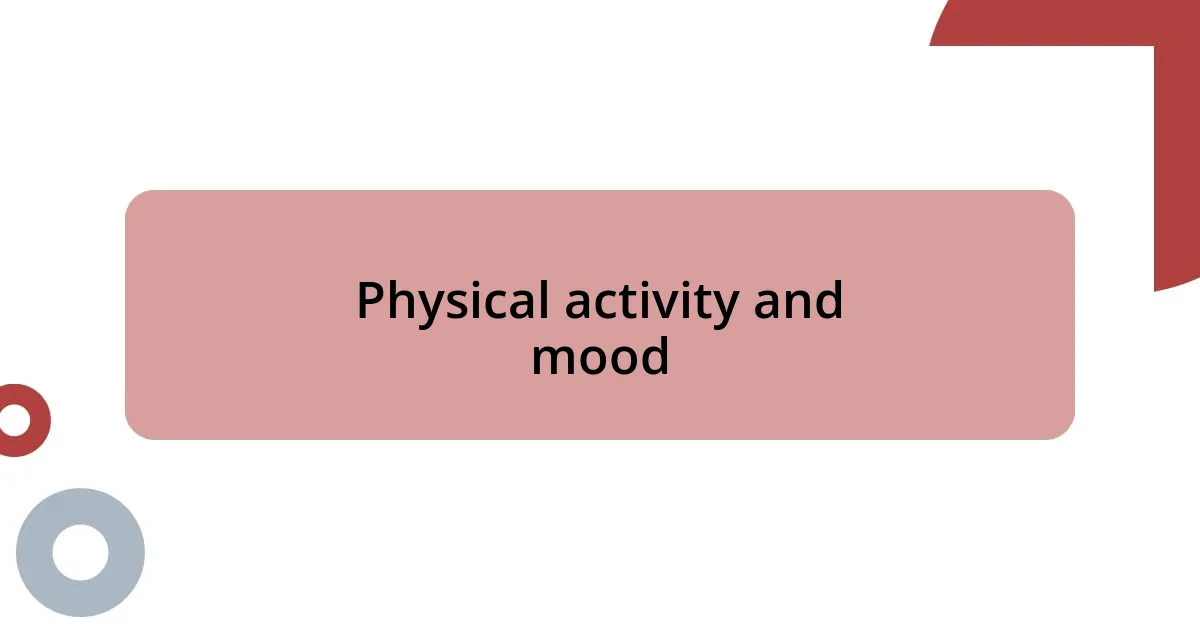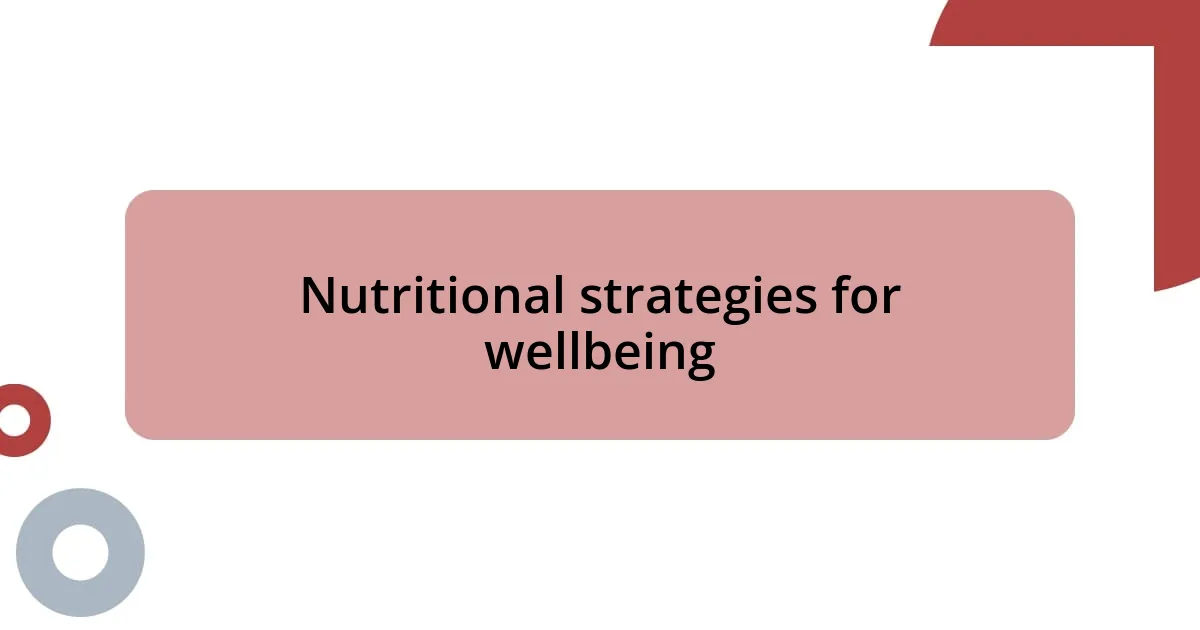Key takeaways:
- Recognizing personal triggers is essential for managing depression; identifying specific situations, places, or memories can help develop coping strategies.
- Establishing daily routines, such as consistent wake-up times and mindfulness practices, can create stability and a sense of control during turbulent moods.
- Physical activity and nutrition significantly influence mood; regular exercise and a diet rich in whole foods, including omega-3 fatty acids, can enhance emotional well-being.
- Building social connections and seeking professional help provide invaluable support; sharing experiences with others can alleviate feelings of isolation and foster strength.

Understanding personal triggers
Understanding personal triggers is an essential part of managing depression. For me, changes in routine often served as a red flag. I remember a time when a sudden shift in my work schedule sent me spiraling. It made me realize how critical stability is for my mental health. Have you ever noticed certain situations or events that send you into a fog of sadness? Recognizing these patterns can be eye-opening.
It’s fascinating how our environment influences our emotions. I vividly recall walking past a park that used to be a happy place for me; instead of joy, it filled me with a profound sense of loss. This experience highlighted the power of memories and associations that can trigger feelings of sadness. Do you find specific places or memories evoking similar responses? Learning to identify these can help in developing coping strategies.
Even small, seemingly insignificant triggers can have a profound impact. For instance, I once found that certain songs would bring back overwhelming emotions linked to past experiences. Initially, I felt defeated; however, I soon realized that understanding why a song affected me could help diminish its power. Have you found solace in confronting your triggers instead of avoiding them? It’s all about turning those moments into insights that promote healing.

Daily routines for stability
Developing daily routines is crucial for maintaining stability while coping with depression. I often found that having a predictable structure helped ground me, especially on days when my mood felt particularly turbulent. For example, establishing a morning ritual—a cup of tea, a short walk, or a few minutes of mindfulness—set a positive tone for the day. This small act of intentionality made me feel more in control, steering me away from the chaos of my thoughts.
Here are some simple yet effective daily routines that can foster stability:
- Consistent wake-up and sleep times: Aim to go to bed and wake up at the same time daily. This regulates your body’s internal clock.
- Regular meal times: Eating meals at set times helps maintain energy levels and creates a comforting structure.
- Daily physical activity: Whether it’s a brisk walk or yoga, finding movement you enjoy can boost mood and enhance overall well-being.
- Mindfulness or meditation session: Even a few minutes each day focused on breathing can provide clarity and calm.
- Set achievable daily tasks: Completing small tasks, like making your bed or watering plants, fosters a sense of accomplishment.
I’ve learned that when I stick to these routines, particularly amidst challenging times, I feel a little less adrift in my feelings. Having that rhythm in my life is not about rigidity; it’s about creating a space for kindness towards myself amid uncertainty.

Mindfulness techniques for relief
Mindfulness techniques can serve as invaluable tools for alleviating the heaviness of depression. When I first started practicing mindfulness, I was taken aback by how even a few moments of focused breathing could shift my mindset. I remember sitting quietly in my living room, taking deep breaths while visualizing a serene landscape—this small act transformed my anxieties into a sense of calm. Has mindfulness ever created a shift in your emotions? I find it’s often the simplest techniques that yield the most profound results.
A technique I often turn to is body scanning, where I focus on each part of my body, releasing tension and acknowledging sensations without judgment. This practice not only helped me connect to my physical self but also highlighted how often I carried stress unconsciously. I can vividly recall a time when focusing on my tight shoulders made me realize how my stress was manifesting physically; releasing that tension brought a surprising wave of relief. Have you ever taken the time to listen to your body in this way?
Another powerful tool is mindful walking, which I embraced during my daily strolls. Instead of letting my thoughts drift, I started to tune into the sounds around me—the rustle of leaves, the chirping of birds—and this simple shift in focus made those walks feel meditative. It was as if each step evoked a mindfulness of its own, allowing me to appreciate the moment rather than get lost in worries. Have you ever noticed how nature can ground you in the present? I find this practice helps turn ordinary moments into extraordinary experiences of peace.
| Mindfulness Technique | Description |
|---|---|
| Deep Breathing | Focusing on inhaling and exhaling to calm the mind. |
| Body Scanning | Checking in with different body parts to release tension. |
| Mindful Walking | Walking while tuning into the surrounding environment. |

Physical activity and mood
Physical activity plays a remarkable role in shaping mood. I remember a particularly low point when I reluctantly laced up my sneakers, dreading the thought of a run. However, once I stepped outside and felt the cool air hit my face, something shifted. The rhythm of my feet hitting the pavement felt like a release, each step taking me further away from the heaviness I carried. Have you experienced that surprising lift after a workout? It’s fascinating how movement can transform our internal landscape.
Engaging in regular exercise, even as simple as a walk in the park, has become a cornerstone of my coping strategy. There was a time I didn’t believe a brisk 30-minute walk could make much difference in my mood, yet, over time, I’ve noticed a significant boost in my overall sense of well-being. I often think about how those moments of stretching and pushing my body provide not only physical benefits but also a mental clarity I didn’t anticipate. Can you recall a moment when a burst of physical activity helped shake off a cloud of sadness?
I also find that integrating physical activity into my daily routine acts as a kind of emotional anchor. On days when I feel the weight of my thoughts, doing something active, like yoga or dancing in my living room, serves as a reminder that I can still find joy amidst the struggle. There’s an undeniable connection between physical movement and mood elevation—one that I cherish deeply. Have you noticed how your body responds with energy and lightness, even during difficult times? It’s a powerful reminder that our bodies and minds are intertwined in complex and beautiful ways.

Nutritional strategies for wellbeing
Nutrition has been an essential part of my journey in coping with depression. I discovered that my food choices directly influenced my mood, especially after a challenging day. For instance, when I started including more whole foods in my diet—like leafy greens, nuts, and whole grains—I noticed a gradual uplift in my overall feelings of well-being. Have you considered how your diet might be impacting your emotional state?
One memorable change was when I introduced omega-3 fatty acids into my meals. These healthy fats, found in fish like salmon and in walnuts, became a staple for me after reading about their potential benefits for brain health. I recall a day when I prepared a salmon bowl with a vibrant array of veggies; not only was it delicious, but I felt an immediate sense of optimism afterward. Eating right doesn’t just fill the stomach; it can nourish the mind too. Do you have a favorite nutrient-rich meal that lifts your spirits?
Hydration, too, plays a role that often goes overlooked. I remember days when I felt sluggish, and it turned out I hadn’t been drinking enough water. Once I began to prioritize hydration, I realized how much clearer and more energetic I felt. Keeping a water bottle nearby became a simple yet effective strategy for me. What small steps could you take to ensure you’re properly hydrated? It’s fascinating how these seemingly minor adjustments can lead to significant improvements in our emotional health.

Social support and connection
Social support has become a lifeline for me while navigating through depression. I’ll never forget the time I reached out to a friend during an especially dark moment. Just hearing their voice, filled with understanding and empathy, was like a warm embrace that helped lift some of the clouds hanging over me. Have you ever noticed how a simple conversation can shift your perspective on a tough day?
In my experience, connection with others can take many forms, from deep conversations to just sharing a laugh. There was a period when I felt completely isolated, but joining a local support group changed everything for me. Listening to others share their stories reminded me that I wasn’t alone in my struggles. It was comforting to realize that we were all in this together, fighting similar battles. Isn’t it amazing how collective experience can create a sense of belonging?
Finding the right support system has proven invaluable. I’ve often relied on my family and friends, yet it’s those unexpected connections that surprised me the most. For instance, a casual chat with a colleague revealed we both shared similar experiences with mental health. That newfound camaraderie has fostered openness and understanding, reinforcing my belief that vulnerability can lead to incredible strength. How has connecting with others helped you on your journey? Sometimes, reaching out transforms our solitude into shared strength.

Professional help and resources
Seeking professional help was a significant step for me in managing depression. I remember the first time I walked into a therapist’s office; it felt daunting, like stepping into the unknown. But once I started to talk about my feelings, the weight I was carrying began to lift. Have you ever felt that release when you share your burden with someone who truly listens?
Therapy opened my eyes to different coping strategies that I hadn’t considered before. For instance, cognitive-behavioral therapy (CBT) taught me how to reframe my negative thoughts into more balanced perspectives. I recall a particularly enlightening session when my therapist guided me through a technique that helped me challenge my harsh self-criticism. There’s such power in professional guidance—it’s like having a map when you’re lost in a maze. Have you thought about what kind of therapy might resonate with you?
Utilizing resources like hotlines or online therapy platforms has also been a game-changer. I was hesitant at first, but after discovering a well-reviewed app, I engaged with mental health professionals at my own pace. The convenience and anonymity made it easier to open up about my feelings. Isn’t it incredible how accessible help can be today? If you’re feeling stuck, exploring these options might just be the lifeline you need to start navigating toward brighter days.














